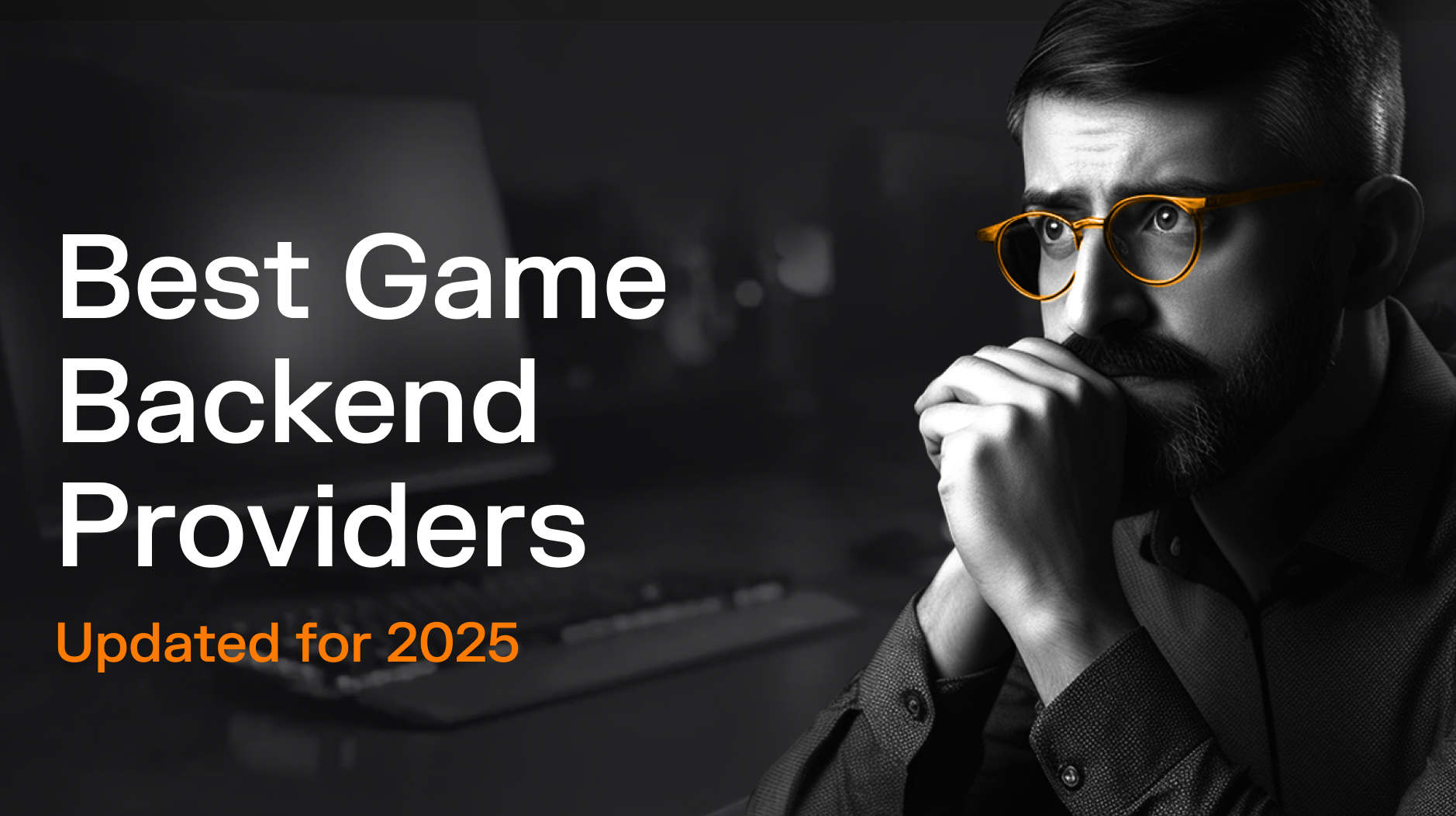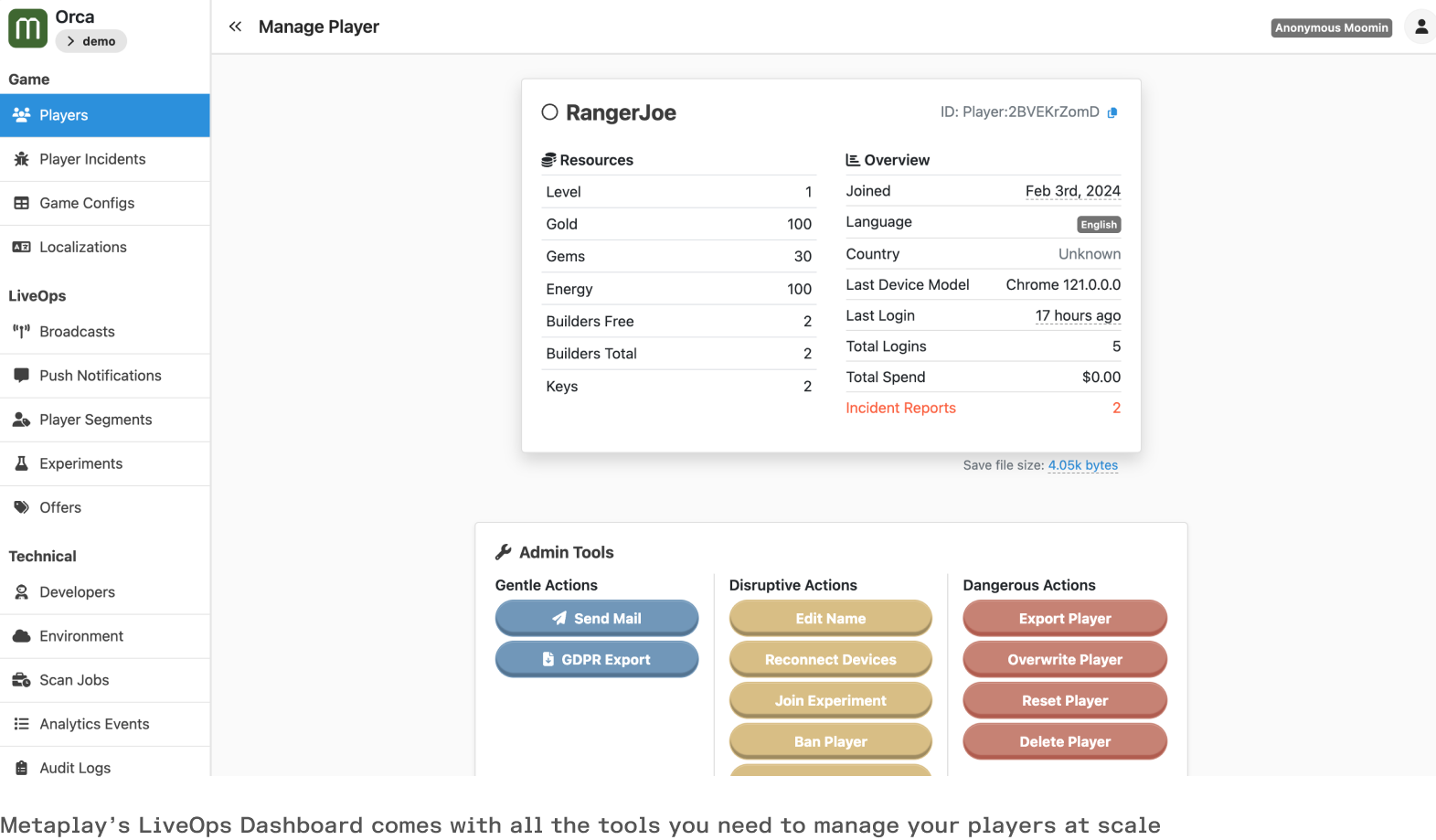
Who Are The Top Mobile Game Backend Providers? [Updated for 2024]
.jpeg)
Chris Wilson •
The right backend technology can propel your mobile game's growth. But with a wide range of BaaS providers in the market, how do you choose the right one for your game?
A robust backend infrastructure is the engine that powers all top-grossing games. It enables engaging gameplay experiences, and handles essential functions such as user authentication, multiplayer capabilities, LiveOps, leaderboards, cloud storage, and much more.
However, there are numerous game backend providers (also called backend-as-a-service) in the market for mobile, PC, console and web games. By the end of this article, you’ll have an understanding of who they are, and how they differ from each other.
Should you build or buy your backend tech?
Most of the companies you see in the top grossing gaming charts use bespoke backend technology that they’ve built in-house. This provides customization and total control of the backend tech stack, but it requires hiring a team of engineers - a time-intensive and costly process.
The vast majority of game developers, however, do not have the time, human resources, or money to invest in building in-house backend tech.
Instead, they use external backend providers, which offer “plug and play” solutions that make the process far more affordable and efficient. In turn, this lets them focus on creating exceptional gameplay experiences.
So which game backend providers are leading the way, whether you're building on mobile or PC, or web or console? (Pro-tip: to stay ahead of your players in 2025, you need to be building on all of them).
Leading PC, mobile and cross-platform game backend providers in 2025
1. Metaplay: the backend of choice for games with top-grossing ambitions
Overview
Metaplay’s backend is particularly suited to developers building a game with a long-term mindset, one that accounts for the evolving tech needs, innovation, and dynamism required to take a game from good to great. Metaplay offers tools to power feature-complete games from day one all the way through to hit status, such as:
Metaplay’s backend solution is suitable for a wide range of games built on Unity, from casual titles to real-time multiplayer experiences. And games made with Metplay can be published on any platform, whether you're building on mobile, PC, console, or web browser.
What sets Metaplay apart from other backend providers is the flexibility of the technology.
Alternative providers offer a limited set of functionalities, which are good enough to get you on par with your competitors. However, when the time comes to innovate, to add custom game features that are not supported by the limited off-the-shelf functionalities, problems emerge.
Specifically, in these cases, developers need to do a major code refactor or migrate their game to a different backend provider. At best, this is a necessary nuisance that drags on for a few months. At worst, it’s a disaster that eats years of development time.
Metaplay, by contrast, offers a tech upgrade path, ensuring game innovation is never stifled by technological limitations.
Metaplay's fully-programmable stack is also server-authoritative and as such, cheat-proof by default, which guarantees developers peace-of-mind as they scale. And because Metaplay ships as source code deployed into a game developer's own cloud, when making games with Metaplay a game studio never has to worry about vendor risk.
The Metaplay SDK includes a pre-built but fully customisable LiveOps and player management dashboard, which has everything ambitious game developers need to engage, retain, and monetize their players as their game grows.
Click here to learn more about Metaplay’s backend for mobile game developers.
Pricing
Pricing for Metaplay’s backend technology starts at €995 per month for managed development environments, with opportunities to add production and staging environments as you globally launch your game.
Game studios can also choose from a variety of expert support packages tailored to their needs, as well as bespoke Private Cloud options for self-hosting at scale.

2. Beamable
Overview
Beamable provides tools for monetizing players (in-game stores, payment infrastructure, notifications), connecting players (leaderboards, chats, guilds or clans, multiplayer gameplay, tournaments), and optimizing the game experience (analytics into player behaviour, A/B testing for new features, content management for deploying new content).
From a more technical angle, Beamable also provides admin tools for development, microservices that eliminate the need to build and operate a game server, and more.
They also offer both Unity and Unreal SDKs, allowing developers to add Beamable's backend service to games built on either of the leading engines.
Pricing
Beamable's subscription tiers begin at $10 per million API calls, also providing an indie tier for solo or small teams without revenue or funding. For large companies who expect over 200M API calls, Beamable offers special pricing.
3. Azure PlayFab
Overview
Azure PlayFab, owned by Microsoft (and formerly known only as ‘PlayFab’), provides a solid set of building blocks to launch a fully functional game and is one of the longest-running backend solutions, having launched in 2014.
On a high level, PlayFab’s offering can be divided into three pieces: multiplayer tools, LiveOps tools, and analytics.
PlayFab’s tools for multiplayer games include party networking and chat, cross-network identity and data, multiplayer servers for low-latency real time gameplay, leaderboards and statistics, and matchmaking and groups (like guilds or clans).
PlayFab’s LiveOps tools include game economy infrastructure, player communication, automation to set up custom operations and react to events in real-time, content management (like remote updates to game assets), and experiments (like running tests on player segments).
Finally, PlayFab’s real-time analytics lets developers understand how their game is performing and how users are interacting with it. And in terms of data, PlayFab also ensures GDPR and COPPA compliance.
Pricing
PlayFab's pricing has several tiers: a free tier for games with less than 100K users, a pay-as-you-go plan, a standard plan at $99/month, and a premium plan at $1,999/month.
4. Photon
Overview
Photon’s inclusion on this list could be seen as slightly contentious as strictly speaking, it’s not exactly a backend (or at least not in the same sense as the other vendors on this list).
More so, Photon is a multiplayer engine that is particularly valuable for developers aiming to create highly scalable and real-time multiplayer experiences.
One of the standout features of Photon Engine is its low-latency and reliable networking capabilities, which enable seamless real-time multiplayer interactions. This makes it an ideal choice for fast-paced multiplayer games, such as first-person shooters or sports simulations.
Photon also offers extensive matchmaking and lobby management functionality, allowing developers to create custom matchmaking algorithms and efficiently connect players. This feature is invaluable for games that rely on fair and balanced matchmaking, enhancing the overall player experience.
Another great aspect of Photon is its authoritative server support, enabling developers to enforce game rules and prevent cheating. This is crucial for competitive multiplayer games where maintaining a fair and level playing field is so important.
Note that Photon is not a complete backend provider - it focuses on multiplayer game infrastructure. Some developers, for instance, use Photon in tandem with other backend tools like Metaplay to cover all of their mobile game’s backend needs.
Pricing
Pricing for Photon is tiered according to concurrent users (CCU), with options available for indie developers and larger studios.
5. Heroic Labs
Overview
Heroic Labs is a composable product stack featuring an open source game server, a LiveOps platform, a game development toolkit, and managed cloud services.
Nakama, Heroic Labs' flagship tool, is a scalable and flexible backend server for multiplayer games. It provides essential features such as user authentication, real-time multiplayer functionality, social features, leaderboards, and server-side scripting.
Nakama is particularly valuable for developers looking to create large-scale multiplayer experiences across different platforms, as it offers high-performance networking and seamless synchronization.
In addition, Heroic Labs' latest tool, Satori, provides a real-time data platform designed for building live, interactive, and immersive experiences. Satori enables developers to stream data in real-time, facilitating dynamic gameplay, chat systems, and live events.
Satori is particularly useful in instances where real-time data updates and instant communication are essential, such as massively multiplayer online games (MMOs), live competitions, or other collaborative experiences.
Heroic Labs’ cloud tool is another handy feature, letting developers deploy dedicated Nakama and Satori clusters on a managed and private cloud.
Hiro, which is Heroic Labs’ game development kit (GDK), is a client-server library built on the Nakama game server with built-in game economy, social, and LiveOps features pre-made to flexibly integrated into your game.
Pricing
Heroic Labs offers a flexible pricing model, including a free tier for indie developers, and custom plans for larger-scale games.
Choosing the Right Backend Provider for Your Game
When it comes to backend infrastructure for mobile, PC, console, and web and browser games, partnering with an external provider rather than building your own technology offers numerous benefits. Aside from saving significant time and money, developers are able to maintain focus on the number one priority: building an engaging gameplay experience that keeps their players coming back for more.
Choosing the right backend provider is a big decision, and requires a lot of research. Ideally, the backend service you go with from day one will remain your provider over the long-run, as the cost of switching later is higher, and will continue to rise as a game matures.
This article was designed to serve as an overview of the leading mobile game backend providers, but it is far from definitive. Use this as a starting point for conducting deeper research, and remember that your game is likely to evolve in ways you haven’t thought of yet - so ensure your backend provider gives you all the functionalities, scalability, and reliability to support your future tech needs.
FAQ:
Q1: What are the advantages of using a backend-as-a-service for my game instead of building an in-house solution?
A1: Using an external backend provider offers several advantages. Firstly, it saves time and resources, allowing you to focus on core game development. Backend providers specialize in delivering scalable and reliable infrastructure, and in ensuring high performance and stability. Additionally, they offer a wide range of pre-built features, such as user authentication, leaderboards, and real-time multiplayer capabilities, which reduces development effort and speeds up time to market.
Q2: Are these backend providers suitable for both indie developers and larger studios?
A2: Several of these backend providers offer free pricing tiers for smaller indie games, making their services accessible to developers with different budgets. Others, like Metaplay, are more suited to studios that have funding, or a general budget to invest in a more premium backend service.
Q3: Can I migrate an existing mobile game to a different backend provider?
A3: Migrating an existing mobile game to a different backend provider is possible but requires development and integration work - which can cause a headache when you’re trying to focus on efficiently running your game. The extent of this headache depends on the complexity of your game and the compatibility between the backend providers.
Before making a decision, carefully evaluate the migration process, compatibility, and potential benefits of switching providers. For instance, it could be worth the hassle if you’ve reached parity with your competitors, and need to innovate and create custom game features that your existing backend provider doesn’t allow for.
This is why choosing the right backend provider from the start is so important - but bear in mind that it’s impossible to know what your long-term needs are from day one. Just ensure your backend provider offers a tech upgrade path that has all your potential long-term needs covered.
Q4: What level of support do these backend providers offer to developers?
A4: All of the backend providers listed above offer comprehensive developer documentation, tutorials, and forums to assist developers in integrating their services. Some providers also offer dedicated support channels, including Slack channels, email support or live chat, to address technical issues and answer questions.
Q5: Can I customize the features and functionality provided by backend providers to suit my game's unique requirements?
A5: Yes and no. The only backend provider that gives developers total flexibility for game features is Metaplay because it ships as source code deployed into your own cloud, and is fully extensible. Most backend providers offer pre-built features that offer some degree of customization, but the extent of this is usually limited.
It's important to check the documentation and support provided by the backend provider to understand the level of customization available - not just for your current needs, but also for your potential needs further down the line.
Remember, when choosing a backend provider, consider factors such as your game's genre, scalability needs, pricing structure, and the level of support provided. Evaluating these aspects will help you select the best backend provider to power your mobile game and ensure a smooth and engaging player experience.

